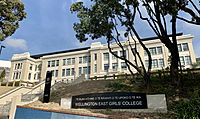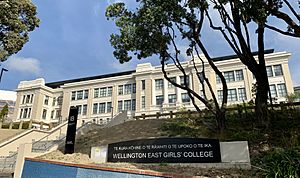Wellington East Girls' College facts for kids
Quick facts for kids Wellington East Girls' College |
|
|---|---|

Wellington East Girls' College
|
|
| Address | |
|
Austin Street,
Mount Victoria, Wellington, New Zealand |
|
| Coordinates | 41°18′10″S 174°47′07″E / 41.3028°S 174.7852°E |
| Information | |
| Type | Single Sex Girls State Secondary (Year 9–13) |
| Established | 1925 |
| Ministry of Education Institution no. | 274 |
| Principal | Gael Ashworth |
| School roll | 1,036 (February 2024) |
| Socio-economic decile | 8P |
| Website | www.wegc.school.nz |
Wellington East Girls' College (WEGC), also known by its Māori name Te Kura Kōhine o te Rāwhiti o Te Upoko o Te Ika, is a public high school just for girls. It is located in Wellington, New Zealand, right above the Mount Victoria Tunnel. The school teaches students from Year 9 to Year 13, which means girls aged about 12 to 18. Currently, the school has around 274 students.
The college mostly serves families from the eastern and southern parts of Wellington, as well as the inner city. However, students also come from other areas like the Hutt Valley and Porirua City. Students from outside the local area can join if they are chosen in a special ballot. The school also has a special unit for about 20 students with special needs. Some of these students also join regular classes.
Contents
School Leaders and Staff
The school has a team of leaders who help run everything. The main leader is the principal.
Who is the Principal?
The school's principal is Gael Ashworth. She took on this role in 2019. Before her, Sally Haughton was the principal from 2007 to 2019. Janice Campbell was the principal for a long time before that, retiring in 2007.
Meet the Leadership Team
The Senior Leadership Team includes the principal and three deputy principals. There is also a special staff member called the principal's nominee. This person makes sure that the school's assessments and qualifications meet the standards set by the New Zealand Qualifications Authority (NZQA).
The school also has a Guidance team. This team helps students with their well-being and future plans. It includes deans for each year level, career advisors, and counsellors. There is also a sports director and many heads of different school departments.
| Period | Principal |
|---|---|
| 1925–1937 | A. M. Batham |
| 1937–1949 | N. G. Isaac |
| 1950–1957 | M. L. Wilson |
| 1957–1967 | M. J. Riley |
| 1968–1981 | N. McMaster |
| 1981–2007 | Janice Campbell |
| 2007–2019 | Sally Haughton |
| 2019–present | Gael Ashworth |
School History
Wellington East Girls' College was built in 1925. It was needed because many more girls in Wellington wanted to go to high school.
Why Was the School Built?
Before Wellington East was built, Wellington Girls' College (then called Wellington Girls’ High School) was very crowded. By the end of World War I, it had over 800 students. This made teaching very difficult, and some classes even had to be held in rented houses nearby. Miss A. M. Batham, who later became the first Headmistress of Wellington East, asked the school board many times for a new school. Finally, they agreed to build one on the other side of the city.
The school was first going to be called Mt Victoria Girls College. However, its name was changed to avoid confusion with Victoria University of Wellington, which was known as Victoria University College at the time.
Founders Day and Recent Events
The school celebrates Founders Day every year on September 15th. In 2015, they held a big reunion to celebrate their 90th birthday.
On September 24, 2024, the school had to be evacuated. This happened after they received a threat by email.
School Houses
In 1931, the Headmistress, Miss Batham, divided the school into six houses. These houses were for sports competitions and other school events.
Original House Names
The first six houses were named Islington, Ranfurly, Onslow, Jellicoe, Fergusson, and Bledisloe. These names came from important people who had been Governors or Governors-General of New Zealand:
- The Lord Islington, the 15th Governor of New Zealand.
- Lieutenant-General The Lord Freyberg, the seventh Governor-General of New Zealand.
- William Onslow, the 11th Governor.
- John Jellicoe, the second Governor-General.
- Sir Charles Fergusson, the third Governor-General.
- Charles Bathurst, the fourth Governor-General.
Before 1950, Ranfurly and Freyberg Houses were renamed Cobham and Freyberg. These new names honored The Viscount Cobham (the ninth Governor-General) and Lieutenant-General The Lord Freyberg. However, in 1941, Freyberg and Cobham houses were removed, and their students joined the other four houses.
Current Houses
Today, Wellington East Girls' College has four houses:
- Sheppard
- Edgar
- Cooper
- Tirikatane
Buildings and School Grounds
The school has several buildings and shares some facilities with Wellington College.
Wellington East Girls' College and Wellington College both help manage the Gifford Observatory.
The Main Building
The original main building of the school has a special architectural style called interwar stripped classical. It is considered a very important historic place by Heritage New Zealand.
In 2011, work began to make the building stronger against earthquakes. But the work stopped when engineers found that the building was not strong enough. It only met 17% of the national building standard, which is much lower than the required 34% for old buildings. The building, built in 1924, was empty until late 2014. Then, work started again to replace the building. The plan was to keep the front of the old historic building but build a new, multi-story block behind it.
The old main building used to have nine classrooms, a music department, the library, the staffroom, and offices. About 250 students used these spaces.
New and Renovated Areas
After the main building closed, many parts of the school had to move. The Mathematics department, the School Office, Student Services Centre, Hauora Centre (which helps with student well-being), and the Senior Management offices all moved to "The Village." This was a group of temporary buildings on the old lower netball courts. When the new main building opened, these temporary buildings were removed, and the area became a car park.
The music department was in a part of the main building that could still be used until it was taken down in 2014. It then moved to temporary buildings on the top field. The Art Department also moved to temporary buildings while the South Wing (built in 1966) was being renovated.
Many buildings on the school site have been redeveloped. In 2016, the Sports Centre was strengthened and repainted. The school baths, built in 1958, have been completely rebuilt. The outdoor swimming pool has also been covered. It seems that only the East Wing (built 1956) and the Science Block (opened 1985) have not been changed.
In April 2019, the new Matairangi block opened. This new building has modern learning spaces, a new library, a canteen, art studios, food technology rooms, music facilities, and a media suite. It also includes a Māori learning space called a Wharenui. With this new building, the school can now teach about 1250 students.
He Huarahi Tamariki: A Special Unit
He Huarahi Tamariki is a special unit for teenage parents. It is part of Wellington East Girls' College. This unit helps about 50 teenage parents, aged 12 to 19, continue their high school education. It is mostly independent and is located in Porirua. It also includes the Griffin 2 School, which is a childcare center for the students' children. The number of students at He Huarahi Tamariki is counted as part of Wellington East Girls' College's total student number.
Famous Former Students
Many talented people have attended Wellington East Girls' College. Here are some of them:
Arts and Humanities
- Marie Bell (1938) – an educator.
- Marie Clay (1942) – a psychologist and education researcher.
- Joy Drayton (1932) – an educator.
- Avis Higgs (1935) – a painter and textile designer.
- Geraldine McDonald (1942) – an academic and education researcher.
- Whetu Tirikatene-Sullivan (1949) – a New Zealand politician.
- Mary Varnham (1961) – a writer, publisher, and former Wellington City Councillor.
Performing Arts
- Sunny Amey (1945) – a theatre director and educator.
- Aivale Cole (formerly Mabel Faletolu) – an opera singer.
- Jennifer Compton (1966) – a poet and playwright.
- Rae de Lisle (1965) – a pianist and educator.
- Barbara Ewing (1955) – an actor.
- Chelsie Preston Crayford (2003) – an actor.
- Dawn Sanders (1968) – a theatre scholar and founder of the Shakespeare's Globe Centre New Zealand.
- Jennifer Ward-Lealand (1975) – a screen and theatre actor.
Science
- Brenda Shore (nee Slade) (1938) – a botanist.
Sport
Swimming
- Natasha Hind – won Silver and Bronze medals at the 2010 Commonwealth Games.
- Meda McKenzie (1978) – the first woman to swim across the Cook Strait twice.
- Emma Robinson (New Zealand swimmer) – a swimmer at the 2016 Summer Olympics.
Association Football (Soccer)
- Cinnamon Chaney (1988) – a New Zealand international player.
- Maria George – a New Zealand international player.
- Wendi Henderson (1987) – a New Zealand international player.
- Renee Leota (2007) – a New Zealand international player.
Cricket
- Linda Henshilwood (1967) – played for the New Zealand Women's cricket team.
Hockey
- Niniwa Roberts (1994) – a Black Sticks team member and Olympic athlete in 2004 and 2008.
Netball
- Tiana Metuarau (2018) – a Silver Fern.
- Jean Mitchell (1930) – a Silver Fern.
Other Fields
- Cathy Penney – a pilot.
- Janet Hesketh – a women's rights activist.
Notable Staff
- Saradha Koirala – a poet and writer.


